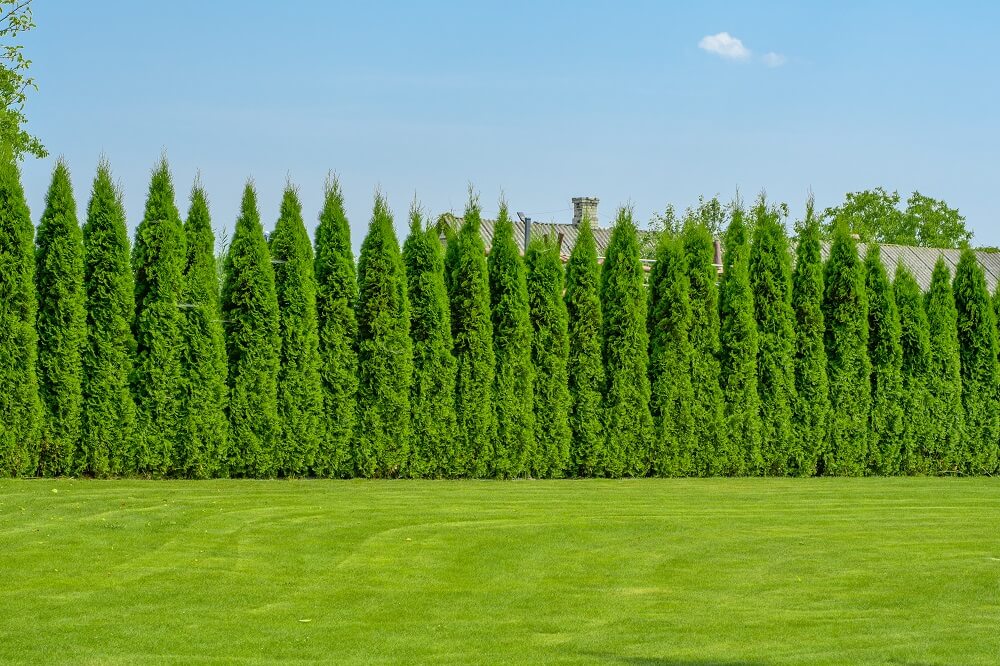
If you are wondering, how to separate thuyas from the lawn, the answer is simple. The most popular methods are the use of kerbs or edging. This is an excellent way to separate the tui from the lawn, while also providing an aesthetically pleasing garden. Edging can be made from a variety of materials, the most popular of which are wood and plastic.
How to separate thuyas from the lawn? Don’t worry, the process is quite simple. First, mark out the area you want to separate and then prepare the materials. Place the edging or kerbing along the line you have marked out, making sure they are properly fixed, for example. anchors. Remember to always use thoughtful solutions that are most suitable for your garden.
Selection garden edging to separate the tui from the grass is extremely important. One of the most popular choices is wooden edging. They are natural, aesthetically pleasing and easy to install. In addition, wood blends perfectly with the thuyas to create a cohesive and harmonious landscape. However, they are subject to rotting processes and decay over time, making them in need of replacement.
You can also opt for garden edging made of plastic. They are cheaper, easy to maintain and come in many colours and designs to match the style of the garden. In addition, they are durable, minimalist and easy to mould.
If you are still wondering, how to separate thuyas from grass, you should also consider using natural stone. Stone is durable, indestructible and gives a natural effect. Choosing the right material depends not only on your taste, but also on the conditions in your garden. For example, if the site is exposed to strong winds or large amounts of rain, you should choose a material that can withstand these types of conditions, such as plastic or stone edging. Remember that the most important thing is to maintain harmony between all the elements in your garden, so it is worth considering different options before you make your final decision.
Question, how to separate thuyas from the lawn often arises among people with their own garden. An important consideration is the proper preparation and installation of garden edging. The first step in this process is to mark out the exact area where you want to place the edging. Next, we prepare a trench for the edging — this should be slightly wider and deeper than the edging itself. The next step is to lay the edging. It is important to make sure that the edging is at the right level and looks aesthetically pleasing.
Garden edgings should be properly fixed, which depends on the type of material chosen. For wooden edging, special pegs should be used to help hold it in place. Plastic edging requires the use of anchors. The final stage is to backfill the trench and make sure the edging is well set and stable. Garden edging prepared in this way will effectively separate the thuyas from the lawn, while adding to the beauty of the garden. Remember, however, that this process requires patience and diligence, but the end result will certainly be worth the effort you put in.
Properly selected garden edging and proper delineation helps to create a nice and functional garden. Answer to the question, With what to separate the thuyas from the lawn, is crucial to maintaining the integrity of each element of the garden, both aesthetically and functionally. Garden edgings offer a variety of shapes and materials, making them adaptable to any style of garden. From an aesthetic point of view, well-chosen edging can enhance the beauty of a tui or any other plant, separating it from the lawn and creating a harmonious contrast between the different zones of the garden.
From a functional point of view, garden edging are equally important. They help to keep the lawn in check by preventing the spread of weeds. Properly installed edging can also prevent soil erosion.
Hardened borders, such as those made of stone or concrete, need little maintenance. Typically, cleaning off leaves or other garden waste is all that is needed to keep them in perfect condition. Plastic edging is also virtually maintenance-free. Occasionally there may be some cracking, but this does not happen very often. Wooden edging, on the other hand, requires a little more attention. Pests such as fungi and insects can appear on them, so it is worth checking their condition regularly. They can also decay over time, so they need to be replaced with new ones.
Regardless, how to separate thuyas from grass, regular grass cutting along the perimeter is crucial. This helps to maintain a clear border and prevents the grass from overgrowing on the thuyas. Furthermore, it is advisable to check the attachment of the edging at least once a year and make appropriate adjustments if necessary. All this contributes to maintaining the aesthetic appearance of the border between the thuyas and the lawn, the effectiveness and attractiveness of which depends on careful maintenance and upkeep.
Still wondering, how to separate thuyas from the lawn? Although traditional garden edging is commonly used, there are also alternatives that can add originality to your garden. One example is rock features. Many gardeners go for naturalness and use stones as a way to separate the thuyas from the lawn. Usually, relatively flat stones are laid along the border. Undoubtedly, this is an innovative method of separation tuj from the lawnwhich introduces an interesting, natural decorative element to the garden. In this way, both the thuyas and the stone accent can be highlighted in an attractive way, adding a unique character to the garden. Remember, however, that such a border requires regular inspection and possible maintenance to maintain its aesthetic appearance and functionality.